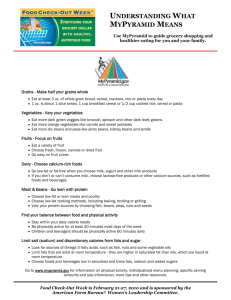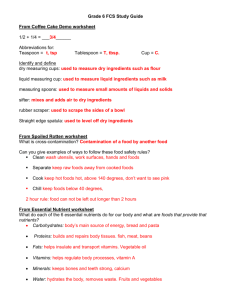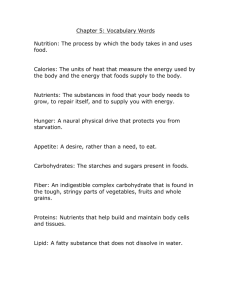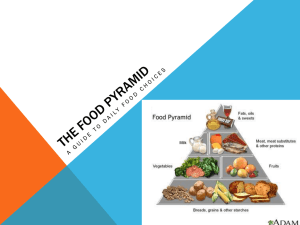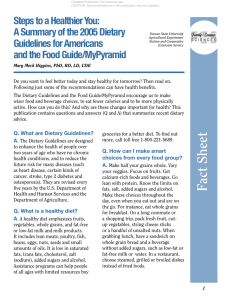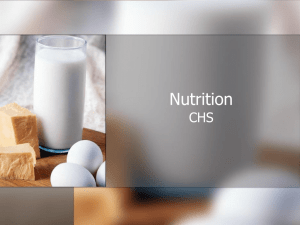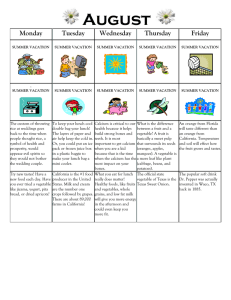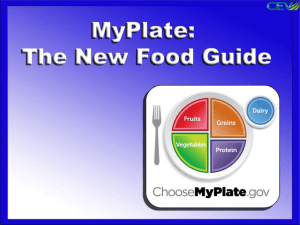Power Point
advertisement
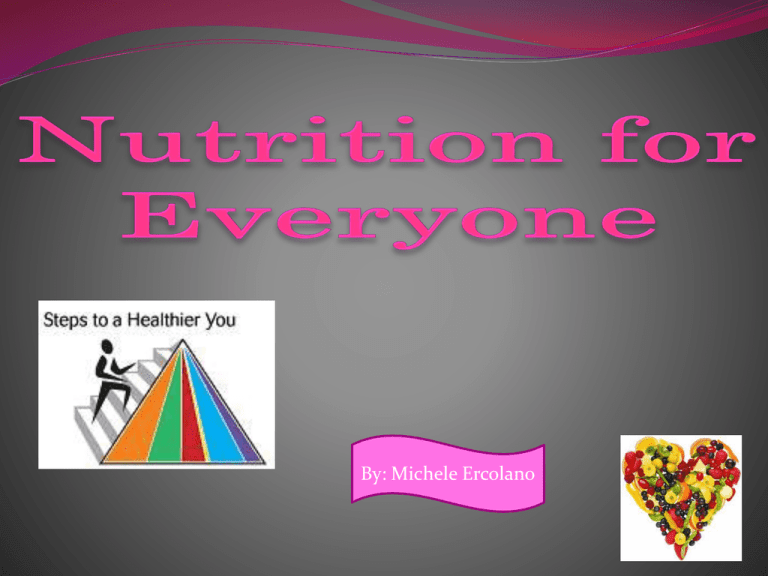
By: Michele Ercolano Nutrients Nutrients in food support growth, maintenance, and repair of the body. Deficiencies, excesses, and imbalances of nutrients bring on the disease of malnutrition. Nutrients (cont) Components of food required for the body’s functioning. Roles • Provides energy • Building material • Maintenance and repair • Support growth Six Classes of Nutrients Water Carbohydrate Energy nutrient 4cal/g Protein Energy nutrient 4 cal/g Vitamins Fat (lipid) Energy nutrient 9 cal/g Minerals Elements of a Healthy Diet Adequacy: get enough of essential nutrients Balance: contains a good proportion of nutrients. No overemphasis of a food group Calorie Control: choose foods to maintain ideal body weight Moderation: eat any food in reasonable-size portions Variety: eat different types of food to prevent boredom 5 Food Groups Grains Vegetables Fruits Milk Meat & Beans Grains Any food made from wheat, rice, oats, cornmeal, barley or another cereal grain is a grain product Examples: Bread Pastas Oatmeal Breakfast cereals Tortillas grits Make at least half your grains whole grains. Vegetables Any vegetable or 100% vegetable juice Vegetable subgroups Dark green vegetables Red and orange vegetables Legumes Starchy vegetables Other vegetables Vary your veggies. Fruits Any fruit or 100% fruit juice! Make half your plate fruits and vegetables. Fruits may be fresh, canned, frozen or dried; and may be whole, cut up, pureed, raw or cooked. Milk All fluid milk products and many foods made from milk. example: cheese & yogurt Although cream cheese, cream, and butter are made from milk, they don’t count in the Milk group because they contain little or no calcium. Try to use fatfree or low-fat (1%) milk. Meats & Beans All foods made from beef, pork, poultry, fish, dry beans or peas, eggs, nuts, and seeds. Try to consume lean meats and poultry How much should I eat everyday? Grains 6 oz Vegetables 2 and half cups Fruits 2 cups Milk 3 cups Meats & Beans 5 and half oz Oils Are not a food group Use Sparingly!! They provide essential nutrients Foods naturally high in oils: Nuts Olives Some fish Avocados Empty Calories calories from solid fats and/or added sugars Solid fats: fats that are solid at room temperature Added sugars: are sugars and syrups that are added when foods or beverages are processed or prepared. Ex. of where some empty calories come from: Cakes, cookies, pastries, and donuts Sodas, energy drinks Drink water Ice cream instead of sugary drinks. Sodas, energy drinks Physical Activity For health benefits, physical activity should be moderate or vigorous intensity. Try to find your balance between food and exercise. Get at least 30 minutes most days of the week. Body Mass Index (BMI) Body mass index is a measure of body fat based on height and weight that applies to adult men and women. Categories Underweight = <18.5 Normal weight = 18.5–24.9 Overweight = 25–29.9 Obesity = BMI of 30 or greater Aim for a healthy weight! Calculate your BMI How to Calculate Your B.M.I.: (weight in pounds / (height in inches x height in inches)) x 703 Tips! Drink at least 8 glasses a water a day! DONT FORGE T… ALWAYS EAT BREAKFAST! Limit sugars Include green, orange, and yellow fruits and vegetables Eat a variety of foods. Balance calorie intake with energy output More Tips! Maintain an adequate calcium intake. If you drink alcohol, do so in moderation. Stay away from trans fats Cut down on saturated fats Eat foods that are high in fiber Get your vitamins and minerals from foods, not from supplements. Useful Websites! http://www.choosemyplate.gov/ http://www.wellnessletter.com/html/fw/fwNut01Healt hyDiet.html http://www.permanente.net/homepage/kaiser/pdf/61 28.pdf
